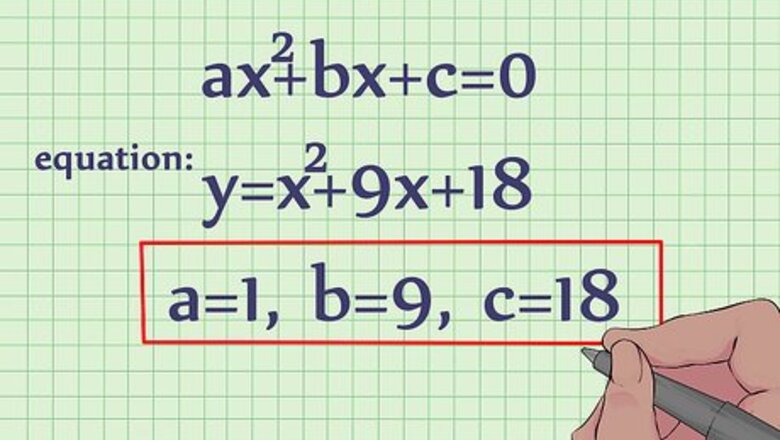
views
Using the Vertex Formula
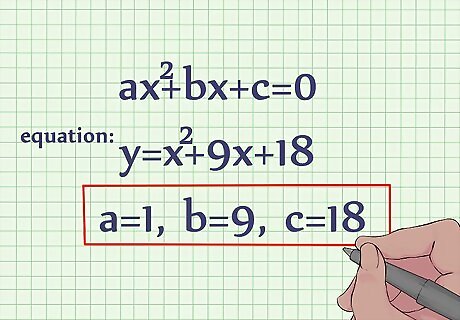
Identify the values of a, b, and c. In a quadratic equation, the x 2 {\displaystyle x^{2}} x^{2} term = a, the x {\displaystyle x} x term = b, and the constant term (the term without a variable) = c. Let's say you're working with the following equation: ' y = x 2 + 9 x + 18 {\displaystyle y=x^{2}+9x+18} {\displaystyle y=x^{2}+9x+18}. In this example, a {\displaystyle a} a = 1, b {\displaystyle b} b = 9, and c {\displaystyle c} c = 18.
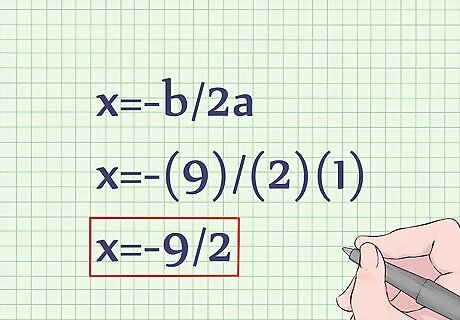
Use the vertex formula for finding the x-value of the vertex. The vertex is also the equation's axis of symmetry. The formula for finding the x-value of the vertex of a quadratic equation is x = − b 2 a {\displaystyle x={\frac {-b}{2a}}} {\displaystyle x={\frac {-b}{2a}}}. Plug in the relevant values to find x. Substitute the values for a and b. Show your work: x = − b 2 a {\displaystyle x={\frac {-b}{2a}}} {\displaystyle x={\frac {-b}{2a}}} x = − ( 9 ) ( 2 ) ( 1 ) {\displaystyle x={\frac {-(9)}{(2)(1)}}} {\displaystyle x={\frac {-(9)}{(2)(1)}}} x = − 9 2 {\displaystyle x={\frac {-9}{2}}} {\displaystyle x={\frac {-9}{2}}}
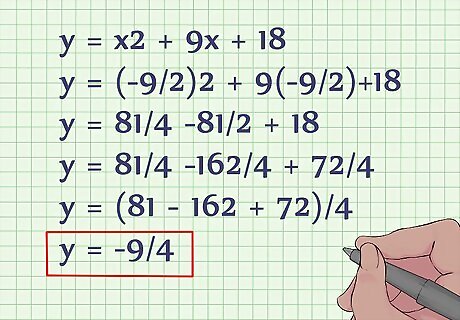
Plug the x {\displaystyle x} x value into the original equation to get the y {\displaystyle y} y value. Now that you know the x {\displaystyle x} x value, just plug it in to the original formula for the y {\displaystyle y} y value. You can think of the formula for finding the vertex of a quadratic function as being ( x , y ) = [ ( − b 2 a ) , f ( − b 2 a ) ] {\displaystyle (x,y)=\left[({\frac {-b}{2a}}),f({\frac {-b}{2a}})\right]} {\displaystyle (x,y)=\left[({\frac {-b}{2a}}),f({\frac {-b}{2a}})\right]}. This just means that to get the y {\displaystyle y} y value, you have to find the x {\displaystyle x} x value based on the formula and then plug it back into the equation. Here's how you do it: y = x 2 + 9 x + 18 {\displaystyle y=x^{2}+9x+18} {\displaystyle y=x^{2}+9x+18} y = ( − 9 ) ( 2 ) 2 + 9 ( − 9 ) ( 2 ) + 18 {\displaystyle y={\frac {(-9)}{(2)}}^{2}+9{\frac {(-9)}{(2)}}+18} {\displaystyle y={\frac {(-9)}{(2)}}^{2}+9{\frac {(-9)}{(2)}}+18} y = 81 4 − 81 2 + 18 {\displaystyle y={\frac {81}{4}}-{\frac {81}{2}}+18} {\displaystyle y={\frac {81}{4}}-{\frac {81}{2}}+18} y = 81 4 − 162 4 + 72 4 {\displaystyle y={\frac {81}{4}}-{\frac {162}{4}}+{\frac {72}{4}}} {\displaystyle y={\frac {81}{4}}-{\frac {162}{4}}+{\frac {72}{4}}} y = ( 81 − 162 + 72 ) 4 {\displaystyle y={\frac {(81-162+72)}{4}}} {\displaystyle y={\frac {(81-162+72)}{4}}} y = − 9 4 {\displaystyle y={\frac {-9}{4}}} {\displaystyle y={\frac {-9}{4}}}
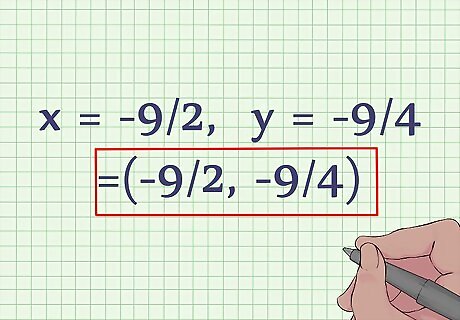
Write down the x {\displaystyle x} x and y {\displaystyle y} y values as an ordered pair. Now that you know that x = − 9 2 {\displaystyle x={\frac {-9}{2}}} {\displaystyle x={\frac {-9}{2}}}, and y = − 9 4 {\displaystyle y={\frac {-9}{4}}} {\displaystyle y={\frac {-9}{4}}}, just write them down as an ordered pair: ( − 9 2 , − 9 4 ) {\displaystyle ({\frac {-9}{2}},{\frac {-9}{4}})} {\displaystyle ({\frac {-9}{2}},{\frac {-9}{4}})}. The vertex of this quadratic equation is ( − 9 2 , − 9 4 ) {\displaystyle ({\frac {-9}{2}},{\frac {-9}{4}})} {\displaystyle ({\frac {-9}{2}},{\frac {-9}{4}})}. If you were to draw this parabola on a graph, this point would be the minimum of the parabola, because the x 2 {\displaystyle x^{2}} x^{2} term is positive.
Completing the Square
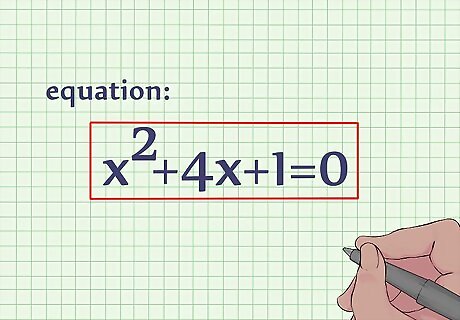
Write down the equation. Completing the square is another way to find the vertex of a quadratic equation. For this method, when you get to the end, you'll be able to find your x and y coordinates right away, instead of plugging the x coordinate back in to the original equation. Let's say you're working with the following quadratic equation: x 2 + 4 x + 1 = 0 {\displaystyle x^{2}+4x+1=0} {\displaystyle x^{2}+4x+1=0}.
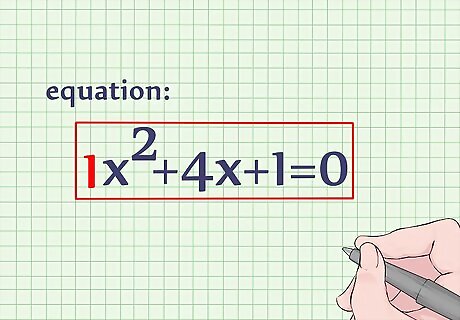
Divide each term by the coefficient of the x 2 {\displaystyle x^{2}} x^{2} term. In this case, the coefficient of the x 2 {\displaystyle x^{2}} x^{2} term is 1, so you can skip this step. Dividing each term by 1 would not change anything. Dividing each term by 0, however, will change everything.
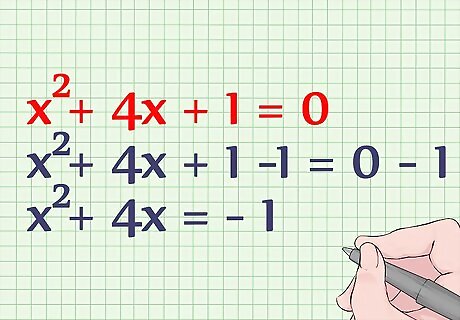
Move the constant term to the right side of the equation. The constant term is the term without a coefficient. In this case, it is 1. Move 1 to the other side of the equation by subtracting 1 from both sides. Here's how you do it: x 2 + 4 x + 1 = 0 {\displaystyle x^{2}+4x+1=0} {\displaystyle x^{2}+4x+1=0} x 2 + 4 x + 1 − 1 = 0 − 1 {\displaystyle x^{2}+4x+1-1=0-1} {\displaystyle x^{2}+4x+1-1=0-1} x 2 + 4 x = − 1 {\displaystyle x^{2}+4x=-1} {\displaystyle x^{2}+4x=-1}

Complete the square on the left side of the equation. To do this, simply find ( b 2 ) 2 {\displaystyle ({\frac {b}{2}})^{2}} {\displaystyle ({\frac {b}{2}})^{2}} and add the result to both sides of the equation. Plug in 4 for b {\displaystyle b} b, since 4 x {\displaystyle 4x} 4x is the b-term of this equation. ( 4 2 ) 2 = 2 2 = 4 {\displaystyle ({\frac {4}{2}})^{2}=2^{2}=4} {\displaystyle ({\frac {4}{2}})^{2}=2^{2}=4}. Now, add 4 to both sides of the equation to get the following: x 2 + 4 x + 4 = − 1 + 4 {\displaystyle x^{2}+4x+4=-1+4} {\displaystyle x^{2}+4x+4=-1+4} x 2 + 4 x + 4 = 3 {\displaystyle x^{2}+4x+4=3} {\displaystyle x^{2}+4x+4=3}
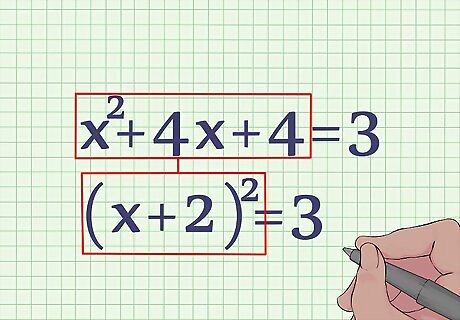
Factor the left side of the equation. Now you will see that x 2 + 4 x + 4 {\displaystyle x^{2}+4x+4} {\displaystyle x^{2}+4x+4} is a perfect square. It can be rewritten as ( x + 2 ) 2 = 3 {\displaystyle (x+2)^{2}=3} {\displaystyle (x+2)^{2}=3}
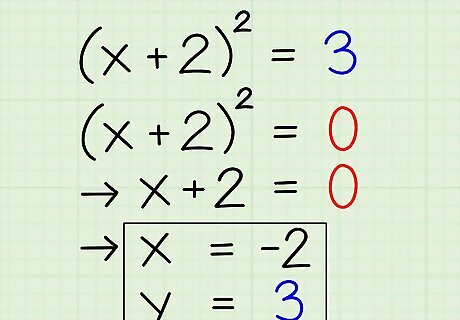
Use this format to find the x {\displaystyle x} x and y {\displaystyle y} y coordinates. You can find your x {\displaystyle x} x coordinate by simply setting ( x + 2 ) 2 {\displaystyle (x+2)^{2}} {\displaystyle (x+2)^{2}} equal to zero. So when ( x + 2 ) 2 = 0 {\displaystyle (x+2)^{2}=0} {\displaystyle (x+2)^{2}=0}, what would x {\displaystyle x} x have to be? The variable x {\displaystyle x} x would have to be -2 to balance out the +2, so your x {\displaystyle x} x coordinate is -2. Your y-coordinate is simply the constant term on the other side of the equation. So, y = 3 {\displaystyle y=3} {\displaystyle y=3}. You can also do a shortcut and just take the opposite sign of the number in parentheses to get the x-coordinate. So the vertex of the equation x 2 + 4 x + 1 = ( − 2 , − 3 ) {\displaystyle x^{2}+4x+1=(-2,-3)} {\displaystyle x^{2}+4x+1=(-2,-3)}.
















Comments
0 comment